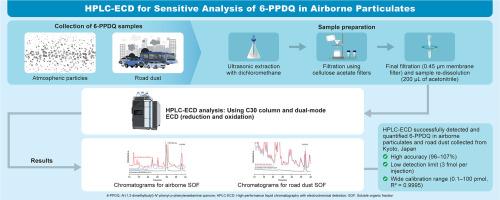Application of high-performance liquid chromatography with electrochemical detection for the analysis of N-(1,3-dimethylbutyl)-N’-phenyl-p-phenylenediamine quinone in ambient particulates
IF 3.2
引用次数: 0
Abstract
A simple and sensitive high-performance liquid chromatography (HPLC) method with electrochemical detection (ECD) was developed for measuring N-(1,3-dimethylbutyl)-N’-phenyl-p-phenylenediamine quinone (6-PPDQ) in environmental samples. The system used C30 columns for sample separation and a dual-mode electrochemical detector with a reduction cell, followed by an oxidation/detection cell connected in series. Under the optimal reduction voltage (–600 mV vs. Au) and optimal oxidation voltage (+600 mV vs. Ag/AgCl), the assay demonstrated high accuracy (96 %–107 %) when applied to airborne particulate sample extracts spiked with known amounts of 6-PPDQ. The detection limit was 3 fmol per injection (signal-to-noise ratio = 3), with a calibration range of 0.1–100 pmol, exhibiting excellent linearity (R2 > 0.9995). Using this newly developed HPLC-ECD analytical method with simple sample preparation, daily variations in 6-PPDQ concentrations in airborne particles collected in Kyoto, Japan, ranging from 21 to 165 fmol m–3 (n = 20), were successfully measured, highlighting the high potential of this HPLC-ECD method for routine trace analysis in environmental samples.

应用高效液相色谱-电化学检测法分析环境颗粒物中N-(1,3-二甲基丁基)-N′-苯基-对苯二胺醌
建立了一种简便、灵敏的电化学检测(ECD)高效液相色谱(HPLC)测定环境样品中N-(1,3-二甲基丁基)-N′-苯基-对苯二胺醌(6-PPDQ)的方法。该系统采用C30色谱柱进行样品分离,双模电化学检测器与还原池串联,氧化/检测池串联。在最佳还原电压(-600 mV vs. Au)和最佳氧化电压(+600 mV vs. Ag/AgCl)下,当应用于含有已知量6-PPDQ的空气悬浮颗粒样品提取物时,该分析显示出很高的准确性(96% - 107%)。检出限为3 fmol /次(信噪比= 3),校准范围为0.1 ~ 100 pmol,线性良好(R2 >;0.9995)。利用该新开发的HPLC-ECD分析方法,通过简单的样品制备,成功测量了日本京都空气中6-PPDQ浓度的日变化,范围为21 ~ 165 fmol m-3 (n = 20),突出了该HPLC-ECD方法在环境样品中常规痕量分析的高潜力。
本文章由计算机程序翻译,如有差异,请以英文原文为准。
求助全文
约1分钟内获得全文
求助全文
来源期刊

Journal of chromatography open
Analytical Chemistry
CiteScore
2.50
自引率
0.00%
发文量
0
审稿时长
50 days
 求助内容:
求助内容: 应助结果提醒方式:
应助结果提醒方式:


